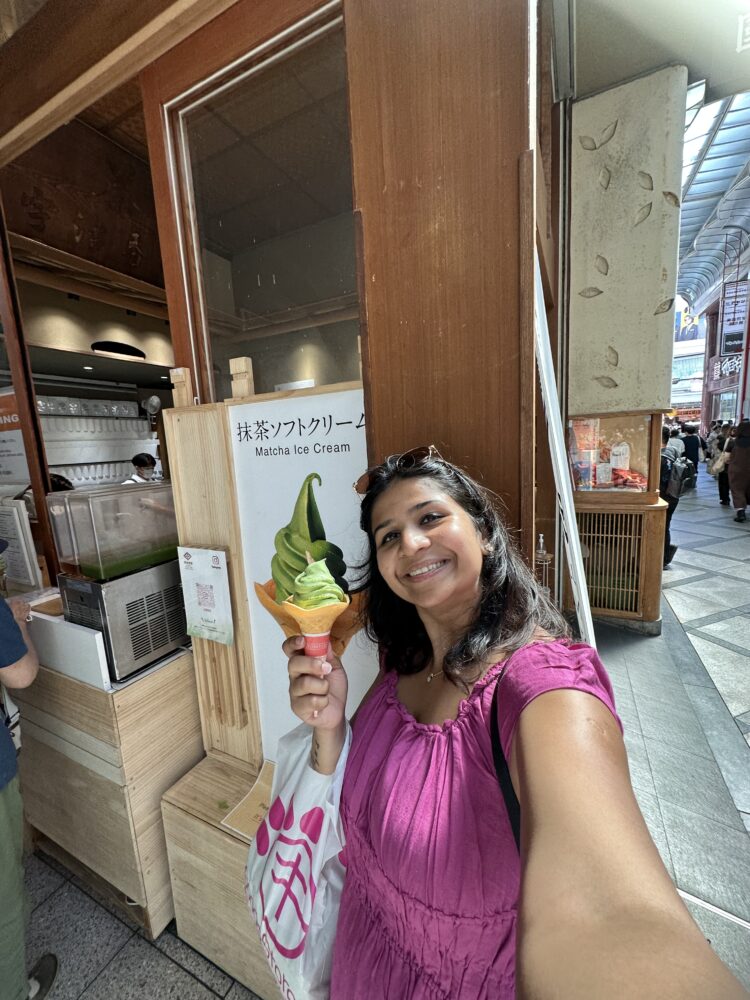A quick day trip to Nara, Japan
Nara is conveniently situated less than an hour away from both Kyoto and Osaka. Thanks to its rich historical significance, the city is abundant with cultural treasures, including some of Japan’s most ancient and grand temples.
Getting there and around
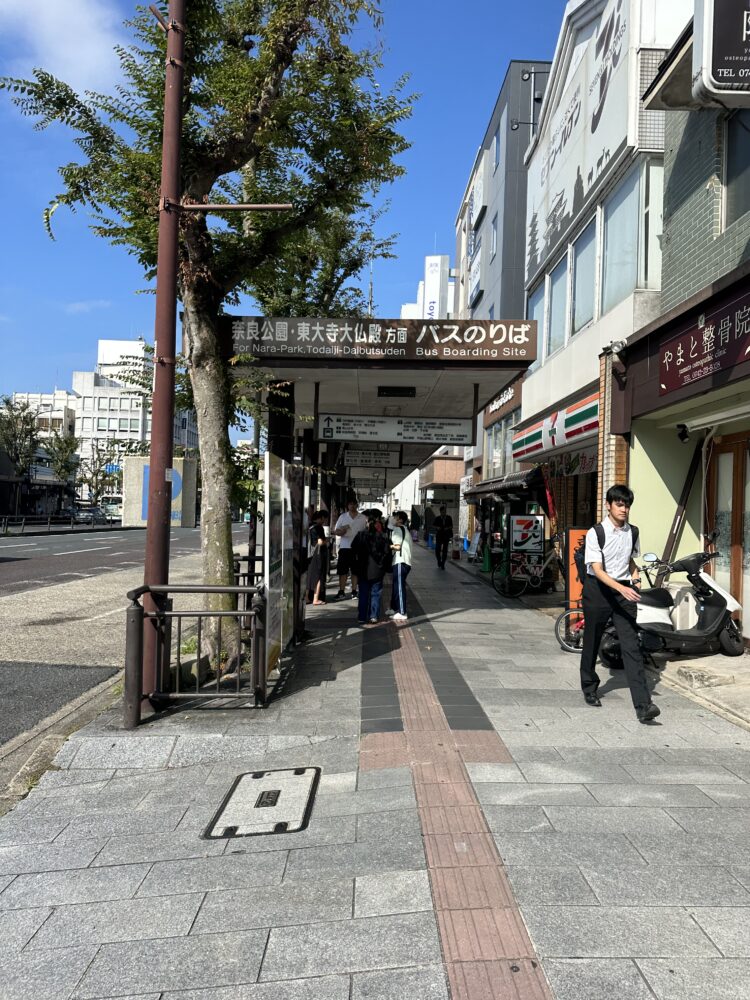
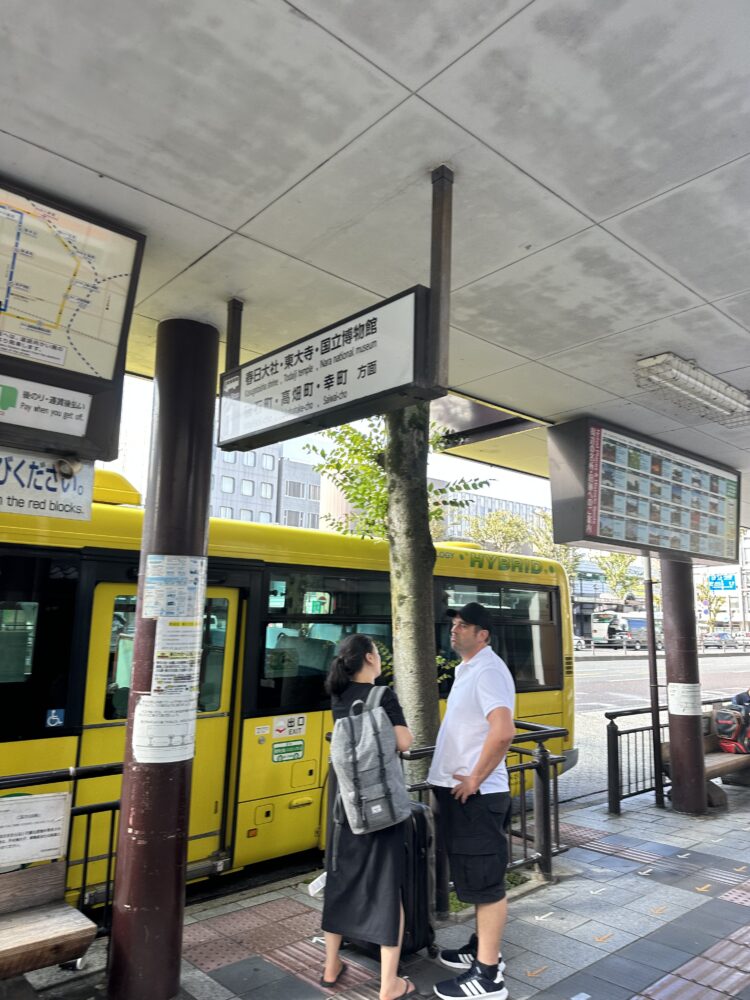
Nara is accessible via two main railway companies: Kintetsu Railways and JR West. The underground Kintetsu station is conveniently located just a short walk from Kofukuji and Nara Park. On the other hand, the JR station is situated a 15-20 minute walk to the west of Kofukuji and the park. To facilitate easy travel between these stations and the various points of interest, Nara Kotsu operates a comprehensive bus network. For added convenience, all major IC cards, such as Suica and Icoca, are accepted on both trains and buses in Nara.
Many of Nara’s key attractions are clustered around the centrally located Nara Park, making them easily accessible on foot. However, for visiting the significant temples like Toshodaiji, Yakushiji, and Horyuji, which are several kilometers away from central Nara, using a bus or train is the most efficient way to reach these destinations.
From Tokyo:
To reach Nara from Tokyo, the most efficient way is via the Shinkansen (bullet train) to Kyoto or Shin-Osaka and then transferring to a local or express train to Nara. The journey involves:
Taking the Shinkansen from Tokyo Station to either Kyoto Station or Shin-Osaka Station. This leg of the journey can take about 2-3 hours, depending on the type of Shinkansen service you choose (Nozomi being the fastest). Upon arrival at Kyoto or Shin-Osaka, switch to a local or rapid service train operated by JR West to JR Nara Station. This part of the trip takes about 45 minutes from Kyoto or about 30 minutes from Shin-Osaka. Alternatively, from Kyoto, you can opt for the Kintetsu Line, which takes you directly to Kintetsu Nara Station, usually in a shorter time (around 35 minutes).
From Kyoto:
Traveling to Nara from Kyoto is more straightforward and quicker:
The JR Nara Line offers a direct route from Kyoto Station to JR Nara Station, taking about 45 minutes. Alternatively, for a faster option, the Kintetsu Kyoto Line connects Kyoto to Kintetsu Nara Station in about 35 minutes. This route is often preferred for its slightly shorter travel time and more frequent departures.
From Osaka:
Reaching Nara from Osaka is quite convenient and quick, making it a popular day trip destination for those staying in Osaka. There are two primary rail options: the JR Line and the Kintetsu Line.
Via JR Line:
The JR Yamatoji Line directly connects JR Osaka Station with JR Nara Station. The journey takes about 50 minutes on a rapid service train. This route is covered by the Japan Rail Pass, making it a cost-effective option for pass holders.
Via Kintetsu Line:
The Kintetsu Nara Line offers a faster connection from Osaka. You can board a train at either Kintetsu Osaka-Namba Station or Kintetsu Uehonmachi Station. The express trains on this line reach Kintetsu Nara Station in about 30-40 minutes. The Kintetsu Line is often preferred for its slightly shorter travel time and more frequent service.
Nara Pass
The Nara Bus Pass offers unlimited travel on Nara Kotsu buses within Nara. There are several options available: a 1-Day Pass for 500 yen, suitable for central Nara and the Toshodaiji/Yakushiji area; a 1-Day Pass Wide for 1000 yen, which also includes the Horyuji area; and a 2-Day Pass for 1500 yen, covering additional areas like Asuka. These passes can be purchased at the bus ticket offices near Kintetsu Nara Station and inside JR Nara Station.
Additionally, there’s a special offering for foreign tourists – the Kintetsu Rail Pass. This pass serves as an extended version of the Nara Bus Pass’s 1-day wide option. It not only allows unlimited bus travel within Nara up to Horyuji but also includes unlimited rides on Kintetsu local, rapid, and express trains connecting Osaka, Nara, and Kyoto. The 1day version of this rail pass is priced at 1500 yen, while the 2day pass is available for 2500 yen.
What to do and see in Nara?
 Todaiji temple: Todaiji is a renowned and historically significant temple in Japan, standing as a prominent symbol of Nara. For a considerable time, the temple’s main hall, known as the Daibutsuden or Big Buddha Hall, held the distinction of being the world’s largest wooden structure. It’s worth noting that the current reconstruction, dating back to 1692, is only two-thirds the size of the original temple hall.
Todaiji temple: Todaiji is a renowned and historically significant temple in Japan, standing as a prominent symbol of Nara. For a considerable time, the temple’s main hall, known as the Daibutsuden or Big Buddha Hall, held the distinction of being the world’s largest wooden structure. It’s worth noting that the current reconstruction, dating back to 1692, is only two-thirds the size of the original temple hall.
Timings: The timings to visit this temple is 7:30 to 17:30 (April to October) and 8:00 to 17:00 (November to March)
Location: 406-1 Zoshicho, Nara, 630-8587, Japan
Getting there: Todaiji is situated in the northern area of Nara Park. Visitors can reach it in approximately 30 minutes on foot from Kintetsu Nara Station or about 45 minutes from JR Nara Station. Additionally, there are bus options available from both stations. Simply alight at Todaiji Daibutsuden, and from there, it’s a brief 5-10 minute stroll to the main building of Todaiji.
Horyuji temple: Horyuji is among Japan’s most ancient temples and boasts the world’s oldest existing wooden edifices. Recognized as a UNESCO World Heritage site in 1993, this temple’s central gate is protected by Japan’s two eldest statues of Kongo Rikishi, the formidable deities typically found guarding significant temple entrances. Standing between the two temple areas is the Gallery of Temple Treasures, constructed in 1998 to showcase a portion of the temple’s extensive art collection. The entry charge is 1500 yen.
Timings: The timings to enter here is 8:00 to 17:00
Location: 1-1 Horyuji Sannai, Ikaruga, Ikoma District, Nara 636-0115, Japan
Getting there: Horyuji is situated approximately 12 kilometers away from central Nara. To reach it from JR Nara Station, you can board the Yamatoji Line, which frequently departs for Horyuji Station (12 minutes, 230 yen). From Horyuji Station, it’s a 20-minute walk or a short bus ride on bus number 72 to the temple (190 yen for a one-way ticket, with departures every 20 minutes). You can alight at the Horyujisando bus stop. Alternatively, from JR or Kintetsu Nara Station, you can take bus number 98 to Horyuji-mae. This one-way journey lasts about an hour and costs 770 yen. There is one bus per hour. The return bus from Horyuji to central Nara is designated as bus number 97.
Omizutori: Omizutori, also known as Shunie, is an annual series of events taking place from March 1 to 14 at Todaiji Temple. This collection of repentance rituals has a remarkable history, being observed continuously for over 1250 years, making it one of Japan’s oldest recurring Buddhist events. Among the various ceremonies that comprise Omizutori, the most renowned and awe-inspiring is Otaimatsu. As the sun sets on each evening from March 1 to 14, enormous torches, ranging in size from six to eight meters, are carried up to the balcony of Nigatsudo and held high above the gathered crowd.
Timings: To visit here the event carries on from 1st to 14th march.
Location: 406-1 Zoshicho, Nara, 630-8587, Japan
Getting there: Omizutori is held at Nigatsudo, a ten minute walk uphill from Todaiji Temple’s main building.

Isuien: Isuien is a captivating Japanese garden that incorporates various unique elements, including the incorporation of Todaiji Temple’s Nandaimon Gate and the picturesque Mount Wakakusayama as part of its “borrowed scenery.” The name “Isuien” translates to “garden founded on water,” a fitting description as the garden’s ponds are supplied with water from the nearby Yoshikigawa River. Adjacent to Isuien, you’ll find the Yoshikien Garden. Isuien itself is divided into two distinct sections: a front garden and a rear garden, with several charming tea houses nestled throughout the landscape. The entry charges is 1200 yen per person.
Timings: The timings to visit this place is 9:30 to 16:30 and tuesdays are usually off.
Location: 74 Suimoncho, Nara, 630-8208, Japan
Getting there: Situated in the heart of Nara, a trip to Isuien Garden can be conveniently incorporated into your visit to nearby attractions like Todaiji Temple and Kofukuji Temple, both just a brief ten-minute stroll away. For those arriving at Kintetsu Nara Station, Isuien Garden is a mere 15-minute walk. Travelers coming from JR Nara Station can easily reach the garden by hopping on one of the frequently departing buses heading towards Aoyamajutaku or Kunimidai-hacchome, getting off at the Oshiagecho bus stop, which takes approximately 10 minutes and costs 220 yen.


Kasuga Taisha: Kasuga Taisha holds the distinction of being Nara’s most renowned shrine. It was founded during the same period as the city itself and is devoted to the guardian deity responsible for safeguarding the city. In addition to the shrine’s main hall, which can be explored at no cost, there is an inner area that requires a fee for entry, offering visitors a closer look at the shrine’s inner structures. Kasuga Taisha is particularly renowned for its lanterns, generously contributed by devout worshippers. The entry fee for the inner area is 500 yen.
Timings: 6:30 to 17:30 (March to October), 7:00 to 17:00 (November to February)and Inner area: 9:00 to 16:00.
Location: 160 Kasuganocho, Nara, 630-8212, Japan
Getting there: Kasuga Taisha Shrine is situated in the eastern part of Nara Park. It can be reached by foot with a 30-minute walk from Kintetsu Nara Station or a 45-minute walk from JR Nara Station. Alternatively, there are bus services available from both stations that will take you to the Kasuga Taisha Honden bus stop for a fare of 220 yen, and these buses run frequently.
Nara park: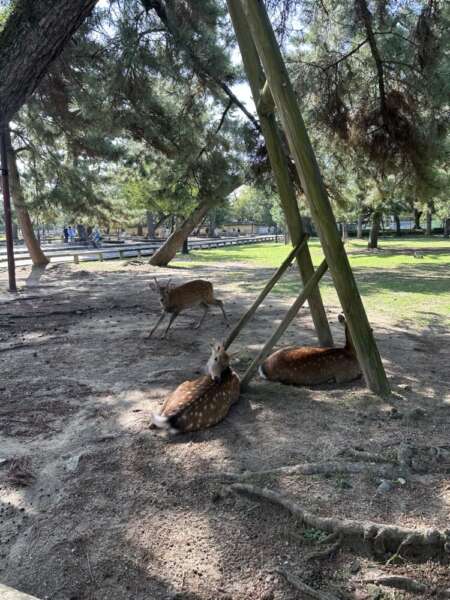
Nara Park, located in central Nara, was established in 1880 and serves as the setting for numerous prominent attractions in Nara, including Todaiji, Kasuga Taisha, Kofukuji, and the Nara National Museum. This expansive park is also inhabited by a multitude of deer that roam freely. Visitors can purchase deer crackers available throughout the park, and some of the deer have even learned to bow as a way of requesting food from visitors. Nara’s deer are surprisingly docile, but they may become assertive if they believe you have food, so it’s important to refrain from teasing them with treats.
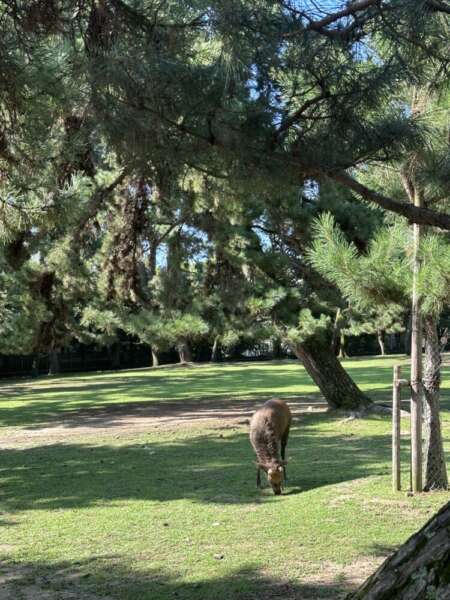 Timings: There is no specific time.
Timings: There is no specific time.
Location: Nara, Japan
Getting there: Nara Park is conveniently situated, just a five-minute walk from Kintetsu Nara Station or approximately a 20-minute walk from JR Nara Station. Alternatively, visitors can access the park by taking a bus, as there are several bus stops located around the park for easy transportation.
Wakakusa Yamayaki: The Wakakusa Yamayaki is a traditional annual festival that involves setting fire to the grass on the hillside of Mount Wakakusayama in Nara. This iconic event, held at the eastern end of Nara Park, creates a spectacular sight visible throughout the city. Prior to the controlled burning of the mountain, the festival kicks off with a captivating fireworks display. The Wakakusa Yamayaki is a highly anticipated event that occurs on the 4th Saturday of January each year, although it may be canceled or rescheduled in the event of unfavorable weather conditions.
Timings: There is no particular timings
Location: Nara park
Getting there: Wakakusayama is conveniently located, just a short 10-15 minute walk from both Todaiji Temple and Kasuga Taisha in Nara. If you’re coming from Kintetsu Nara Station, you can reach the mountain on foot in approximately 35 minutes, or if you’re arriving at JR Nara Station, it’s about a 50-minute walk. Alternatively, there are bus services available from either station that can take you as far as Kasuga Taisha for a fare of 220 yen.
 Toshodaiji temple: Toshodaiji Temple, established in 759, has a significant historical background. It was founded by Ganjin, a Chinese priest who received an invitation from the emperor to come to Japan. His mission was to train priests and enhance the practice of Buddhism in Japan. Interestingly, the temple’s lecture hall, known as the kodo, originally served as an administrative building within the Nara Imperial Palace. Over time, it was relocated to Toshodaiji, and today, it stands as the sole surviving structure from the former palace.
Toshodaiji temple: Toshodaiji Temple, established in 759, has a significant historical background. It was founded by Ganjin, a Chinese priest who received an invitation from the emperor to come to Japan. His mission was to train priests and enhance the practice of Buddhism in Japan. Interestingly, the temple’s lecture hall, known as the kodo, originally served as an administrative building within the Nara Imperial Palace. Over time, it was relocated to Toshodaiji, and today, it stands as the sole surviving structure from the former palace.
 Timings: The timings to visit this place is 8:30 to 17:00.
Timings: The timings to visit this place is 8:30 to 17:00.
Location: 13-46 Gojocho, Nara, 630-8032, Japan
Getting there: Toshodaiji Temple is near Nishinokyo Station, 500 meters away. From Kintetsu Nara Station, take a 15-minute, 300 yen train to Yamato-Saidaiji, then transfer to the Kintetsu Kashihara Line. Alternatively, buses 72, 78, and 98 connect Kintetsu and JR Nara Stations to the temple (15-20 minutes, 270 yen). The nearest bus stop is Toshodaiji, except for bus 98, which stops at Toshodaiji-higashiguchi, a 5-minute walk away. Return buses (72, 77, 97) are available from Toshodaiji-higashiguchi to central Nara.
Yakushiji temple:
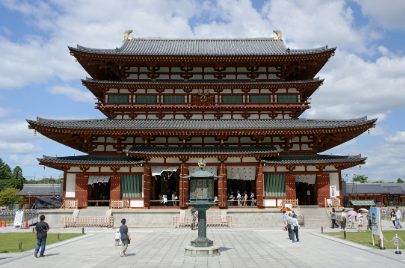
Yakushiji Temple, established in the late 7th century by Emperor Tenmu, was originally built to aid in the healing of his ailing wife. The temple’s significant structure, Genjo-sanzoin Garan, features a unique central octagonal hall where a portion of Genjo-sanzo’s relics are housed. Additionally, there’s a gallery located behind this hall, dedicated to showcasing the art of Hirayama Ikuo, a renowned Japanese painter who passed away in 2009. The entry charges are 1100 Yen.
Timings: The timings to visit this place is from morning 8:30 to 5 in the evening
Location: 457 Nishinokyocho, Nara, 630-8563, Japan
Getting there: Yakushiji Temple is adjacent to Nishinokyo Station, reachable via a 25-minute ride from Kintetsu Nara Station on the Kintetsu Nara Line, then transferring at Yamato-Saidaiji Station to the Kintetsu Kashihara Line (300 yen). Buses 72, 78, and 98 connect Kintetsu and JR Nara Stations to the temple three times an hour (15-20 minutes, 270 yen). The temple’s nearest bus stops are ‘Yakushiji’ (for buses 72 and 78) and ‘Yakushiji Chushajo’ (for bus 98). For the return trip to central Nara, buses 72 or 77 from Nishinokyoeki stop and bus 97 from Yakushiji Chushajo stop are available.
Heijo palace: Spanning approximately one kilometer in both width and length, Heijo Palace was the center of imperial residence and government affairs. Its significant historical and cultural value has earned it a place among Nara’s World Heritage Sites. The site boasts three major reconstructions: the Suzaku Gate and Daigoku Gate, which are the main entrances to the audience hall, and the East Palace Garden (Toin Teien). This garden, complete with a pond, streams, and bridges, was a favored spot for imperial family gatherings and banquets.
Timings: The timings to visit this place is from morning 9 to 4:30 in the evening.
Location: 3 Chome-5-番1号 Nijoojiminami, Nara, 630-8012, Japan
Getting there: Heijo Palace is a brief 15-minute walk from Yamato-Saidaiji Station, which is a quick 5-minute, 240 yen train ride from Kintetsu Nara Station. Alternatively, bus number 14 from JR Nara Station (25 minutes) or Kintetsu Nara Station (15 minutes) also reaches the palace. Key sites include the Excavation Site Exhibition Hall (Heijokyuseki stop), the Imperial Audience Hall (Sakicho stop), and the Nara Palace Site Museum (Nijocho stop), with buses running every half hour.
Naramachi:
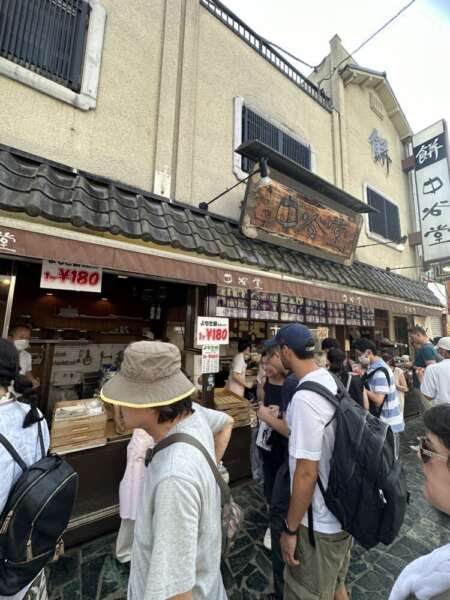 Naramachi, often referred to as “Nara Town”, used to be the bustling merchant area of Nara. Today, it is known for its well-preserved traditional homes and storehouses that are open for public viewing. This charming district is now filled with a variety of boutiques, shops, cafes, restaurants, and a handful of museums nestled along its quaint, narrow streets. Historically, many of Naramachi’s structures during the Edo Period and before were ‘machiya’ – these were elongated townhouses that doubled as both commercial shops and residences for local traders.
Naramachi, often referred to as “Nara Town”, used to be the bustling merchant area of Nara. Today, it is known for its well-preserved traditional homes and storehouses that are open for public viewing. This charming district is now filled with a variety of boutiques, shops, cafes, restaurants, and a handful of museums nestled along its quaint, narrow streets. Historically, many of Naramachi’s structures during the Edo Period and before were ‘machiya’ – these were elongated townhouses that doubled as both commercial shops and residences for local traders.
Timings: The timings to visit this place is not particular.
Location: A neighbour hood in Nara.
Getting there: Naramachi can be reached with a leisurely 10-15 minute walk south from Kintetsu Nara Station. If you’re coming from JR Nara Station, it’s roughly a 20-minute stroll southeast. Conveniently, Nara’s loop buses, numbers 1 and 2, connect both Kintetsu Nara Station and JR Nara Station, and travel along the southern edge of Naramachi, making it easily accessible.
 Yoshikien garden: Yoshikien, a charming Japanese garden, is nestled in the heart of Nara. Its name is derived from the nearby Yoshikigawa River, which flows adjacent to the garden. This serene spot was once the location of the priest residences of the Kofukuji Temple. Within Yoshikien, visitors can explore three distinct sections: a tranquil pond garden, a lush moss garden, and an elegantly designed garden dedicated to tea ceremonies.
Yoshikien garden: Yoshikien, a charming Japanese garden, is nestled in the heart of Nara. Its name is derived from the nearby Yoshikigawa River, which flows adjacent to the garden. This serene spot was once the location of the priest residences of the Kofukuji Temple. Within Yoshikien, visitors can explore three distinct sections: a tranquil pond garden, a lush moss garden, and an elegantly designed garden dedicated to tea ceremonies.
Timings: The timings to visit this place is from 9 am to 5 pm.
Location: 60-1 Noboriojicho, Nara, 630-8213, Japan
Getting there: Situated in the center of Nara, Yoshikien Garden is conveniently close to other major attractions. It’s just a ten-minute stroll from both Todaiji Temple and Kofukuji Temple, making it an ideal addition to your sightseeing itinerary. The garden is also a 15-minute walk from Kintetsu Nara Station. If you’re coming from JR Nara Station, you can easily get to the garden by hopping on buses heading towards Aoyamajutaku or Kunimidai-hacchome, which frequently depart and stop at Oshiagecho (10 minutes, 220 yen).
Kofukji temple:
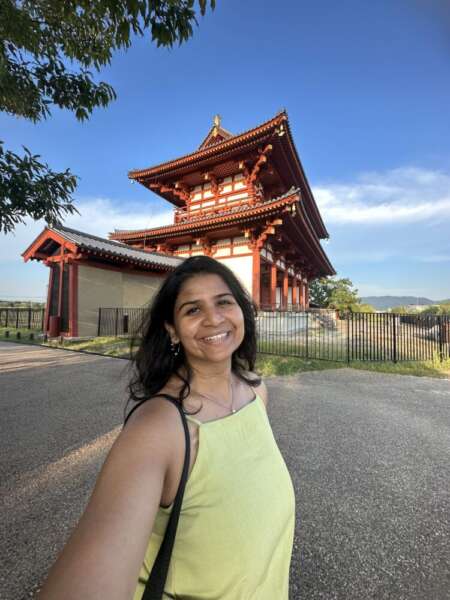
Kofukuji Temple, historically linked to the Fujiwara clan, the most influential aristocratic family during the Nara and Heian periods, is renowned for its architectural heritage. Among its notable structures are a five-storied and a three-storied pagoda. The five-storied pagoda stands out as the second tallest wooden pagoda in Japan, only seven meters shorter than the one at Toji Temple in Kyoto.
Timings: The temple is always open but to visit interiors of it then is from 9 am to 5 pm.
Location: 48 Noboriojicho, Nara, 630-8213, Japan
Getting there: Kofukuji Temple is conveniently located just a five-minute walk from Kintetsu Nara Station. If you’re coming from JR Nara Station, it’s a 20-minute walk. Alternatively, you can take the loop bus that runs clockwise from JR Nara Station or any bus heading towards Kasuga Taisha, which takes about 5-7 minutes and costs 220 yen. Your stop would be Kencho-mae.
Nara National museum:

The Nara National Museum, nestled in Nara Park, specializes in Japanese Buddhist art. Its two wings showcase a permanent collection featuring Buddhist statues, paintings, scrolls, and ritual artifacts predominantly from Japan. Additionally, the newer wing hosts temporary exhibitions, notably the annual autumn exhibition displaying treasures from Todaiji Temple.
Timings: The timings to visit this temple is from 9 am to 5 pm.
Location: 50 Noboriojicho, Nara, 630-8212, Japan
Getting there: Situated in Nara Park, the Nara National Museum is a mere 15-minute walk from Kintetsu Nara Station and a 30-minute walk from JR Nara Station. For those preferring to take a bus, it’s accessible from both stations. Simply alight at the Himuro Shrine/National Museum bus stop, which is conveniently located right next to the museum.
Mount Wakakusa: Mount Wakakusayama, a grassy hill situated behind Nara Park, lies between Todaiji Temple and Kasuga Shrine. This approximately 350-meter-tall mountain offers panoramic views of Nara City. Open to tourists throughout the year, except in winter, a nominal entrance fee is required for access. The slopes of Mount Wakakusayama are adorned with cherry trees, which typically reach full bloom in early April, creating a picturesque scene. The admission charge is 150 yen.
Timings: The timings to visit this place is from 9 am to 5 pm.
Location: Mountain range in Nara
Getting there: The foot of Mount Wakakusayama is conveniently situated just a 10-15 minute walk from both Todaiji Temple and Kasuga Taisha. For those coming from Kintetsu Nara Station, it’s a manageable 35-minute walk, and from JR Nara Station, it’s about a 50-minute stroll. Additionally, there are bus services available from both stations up to Kasuga Taisha, which costs 220 yen, placing you within easy walking distance of the mountain.


